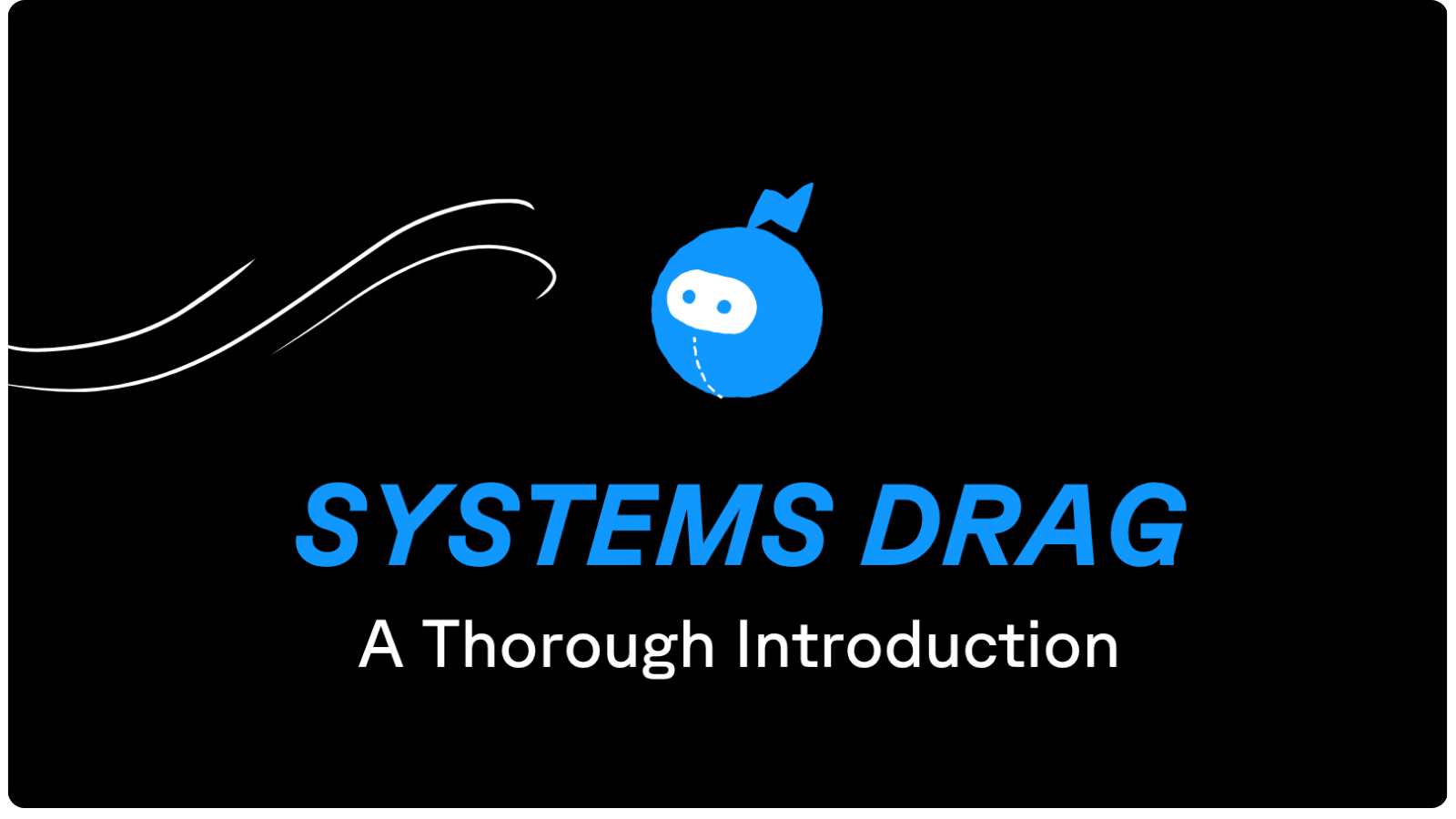Call it the paradox of progress in the modern enterprise: success often brings its own kind of heaviness. Weight. Torpor.
Each new product launch, workflow, or automation promises acceleration — until one day, you realize you’ve built yourself an architecture that’s actually impossible to steer.
Teams at the ground level feel it first.
That creeping slowdown, that missing context, that dashboards that no longer tell the same story twice. Every change seems to take longer than the last.
You’ve hired more people, bought more tools, automated more steps — yet velocity has decreased.
What gives?
Systems Drag, that's what. The compounding friction that saps your team's speed, trust, and momentum from the inside out.
Drag is not a single broken process. It’s the weight of accumulated complexity — the organizational equivalent of plaque in the arteries.
Every new field, every “temporary” workaround, every one-off automation, each adds a layer of drag that slows down execution to a crawl, limits your decision-making, and stretches your confidence.
And because the slowdown happens incrementally, few notice until it’s far too late.
The Anatomy of Systems Drag
Systems drag is a definable, diagnosable condition for your org — one that emerges as one of three interlocking forces: bloat, drag, and extinction risk.
1. System Bloat
Over time, operational systems — especially Salesforce — accumulate let's call them... artifacts of progress. 😅
Custom fields, abandoned workflows, aging integrations, and layers of logic that once served a purpose but now linger as debris. These are the barnacles on the ship of scale (a scaleboat, if you please), individually benign, yet also entirely collectively paralyzing.
Every new initiative that doesn’t retire its predecessor adds weight. In isolation, each decision feels rational — a quick fix, a necessary patch. In aggregate, they create inertia.
2. System Drag
Bloat manifests in your body as a felt experience as systems drag — the lived experience of operational slowdown.
Think of this as the extra seconds every user waits for a process to load. The two-day audit that used to take a couple of hours. The change request that passes through five teams because no one knows who owns the dependency map.
It’s friction disguised as “business as usual.”
And then, it compounds.
Drag increases, and then so do the workarounds, which add even more bloat. Left to its own devices, this self-reinforcing cycle becomes a culture of maintenance. Not a culture of moment.
And what happens to things that don't move, that don't adapt fast enough? Well....
3. Extinction
I'm sorry to say that in the AI era, drag is more than an inconvenience — it’s become something of a deep and intractable existential risk.
Disruptors are disrupting. Competitors that can adapt their systems and strategies in real time will outpace those who can’t.
The companies that fail to address systems drag face the quiet death of irrelevance: slower cycles, noisier data, and leaders making poor decisions based on stale or incomplete information.
Make no mistake: speed will define who survives this era.
Why Systems Drag happens
The origins of drag are as psychological as much as technical.
Cognitive load theory tells us we lowly non-AI humans can only juggle a limited number of elements in our humble working memories. Modern revenue systems exceed that limit by orders of magnitude.
Complexity increases. Teams resort to heuristics. Quick fixes. Local optimizations. Mental shortcuts that solve today’s issue while setting tomorrow’s trap.
From an information theory lens, drag is what you might think of as entropy in motion. Metadata — the schema, lineage, and intent behind data — becomes increasingly uncertain as systems evolve. The more transformations a dataset undergoes, the less anyone understands its meaning. Entropy rises. Clarity falls.
And from an organizational behavior perspective, drag thrives in silos. When incentives reward speed in isolation rather than clarity in collaboration, each department fights for itself. Marketing adds fields for campaign attribution. Sales adds automations for routing. Ops adds custom rules for compliance. Each optimization increases local efficiency — but global disorder.
The result is a company that appears productive on paper but in reality moves like it’s jogging underwater.
The AI Era multiplier
AI was supposed to reverse this trend. We were promised that we could automate away complexity.
Instead, for many teams, AI has simply become a multiplier of chaos.
The problem isn’t the intelligence of AI models. They're plenty smart. They just lack context.
AI without metadata — the structural blueprint of what data means and how it connects — is effectively blind. It can generate responses, but not understanding. It can hallucinate correlations, but not interpret causation.
This is why systems drag corrupts AI performance. When the underlying metadata is broken, models inherit that chaos. Outputs become inconsistent, recommendations irrelevant, and confidence misplaced. The very systems that you built to accelerate progress start to produce noise instead of insight.
Salesforce, in theory, is already a living metadata model — a perfect reflection of your business logic. But its scale and complexity have long outgrown what any human team can meaningfully comprehend or govern.
That’s where the next wave of AI intervention emerges: metadata agents.
The Cost of Inaction
Before we explore the solution, let’s quantify the cost of drag.
Lost velocity: Drag slows execution cycles across every function. What once took days now takes weeks — and each delay is a missed opportunity.
Cognitive burnout: Operators spend up to half their week on reactive maintenance, firefighting instead of innovating.
Financial Waste: Technical debt compounds like interest. Every undocumented dependency or unretired workflow adds risk and rework costs downstream.
Cultural Decay: When systems slow down, so do people. Morale dips. Innovation stalls. Trust in data approaches zero.
This is what we might call organizational time debt... the gap between what teams could achieve and what they actually do under the weight of drag. And the longer it goes unpaid, the steeper the interest gets.
Let's talk about Metadata hygiene
The only sustainable way out is to pull complexity out by its roots — to make systems visible, governable, and continuously adaptive.
Welcome to the era of metadata hygiene?
Metadata hygiene is the discipline of maintaining clarity in your operational blueprint — ensuring every field, automation, and integration is known, purposeful, and contextualized. It’s the foundation for trust in both human and machine decision-making.
And with AI, hygiene evolves from static documentation to active collaboration. Hey, that sounds like a much better world, doesn't it?
Metadata Agents: Our new colleagues
Metadata agents are intelligent assistants that continuously analyze, map, and optimize your Salesforce architecture.
They keep the living context of your org alive — surfacing drag, suggesting fixes, and automating safe execution through a visual workspace.
They enable teams to:
- Spot It Fast — surfacing hidden slowdowns across fields, automations, and dependencies.
- Solve It Fast — recommending safe, automated fixes to streamline change without duct tape.
- Stay Ahead — continuously adapting metadata as your business evolves, protecting against future drag.
In other words: clarity, control, and speed — by design.
The New Operational Philosophy
When we discuss eliminating systems drag here, we’re talking about a philosophical shift in how companies relate to their own systems.
The traditional model has always been to be reactive: systems drift toward chaos until they break, and humans scramble to patch them back together.
The new model is agentic: systems stay self-aware and self-improving, with humans in the loop as orchestrators rather than janitors.
This partnership between human intent and machine context marks the beginning of the Agentic Enterprise — one that can evolve as fast as its environment changes.
All Systems Go
Every organization has drag. You can't 100% avoid it. The difference between stagnation and breakthrough lies in whether you can see it — and whether you have the tools to eliminate it.
In a world where innovation cycles have collapsed from years to hours, clarity has become the new speed.
Companies that master their metadata have a lot of things going for them. They’re more intelligent. Their AI performs better. Their teams execute faster. Their leaders make decisions grounded in reality, not residue.
Because when drag disappears, what’s left is pure, beautiful momentum.

